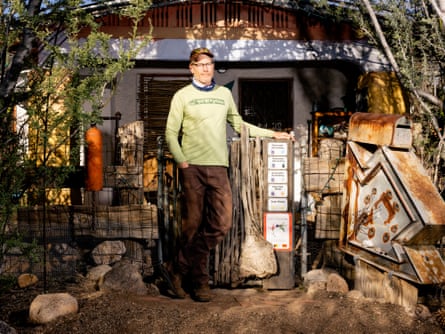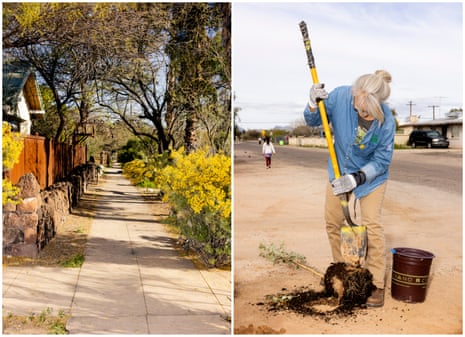Factoids: Tucson’s mayor, Regina Romero, launched Tucson Million Trees in 2020, an initiative to plant 1m drought-tolerant shade trees to help mitigate the impact of climate change.
The work in Dunbar Spring, along with Lancaster’s books and website, have inspired people worldwide to take up water harvesting to irrigate native food-bearing street trees. “In almost every neighborhood in Tucson, you can now find at least one property doing this,” he said.
The work of Dunbar Spring neighborhood foresters has also informed Tucson’s climate action plan, including legalizing citywide rainwater harvesting and planting arid-adapted trees.
‘A living pantry’: how an urban food forest in Arizona became a model for climate action
"Near downtown Tucson, Arizona, is Dunbar Spring, a neighborhood unlike any other in the city. The unpaved sidewalks are lined with native, food-bearing trees and shrubs fed by rainwater diverted from city streets. One single block has over 100 plant species, including native goji berries, desert ironwood with edamame-like seeds and chuparosa bushes with cucumber-flavored flowers.
This urban food forest – which began almost 30 years ago – provides food for residents and roughage for livestock, and the tree canopy also provides relief to residents in the third-fastest warming city in the nation. It has made Dunbar Spring a model for other areas grappling with increased heat, drought and food insecurity caused by the climate crisis.
“We’re creating a living pantry,” said Brad Lancaster, a resident and co-founder of the Dunbar/Spring Neighborhood Foresters organization, which planted the urban food forest.

Dunbar Spring’s urban food forest began on an early morning in September 1996, when residents gathered for the first-ever community-wide tree-planting event. Like many lower-income areas in Tucson, Dunbar Spring was unusually hot, lacking the street tree cover to provide shade during the city’s brutal summers. Temperatures today are 4.5F warmer than in the 1970s.
>The plan, headed up by Lancaster, was to plant multi-use drought-tolerant shade trees in streetside basins that could capture rainwater and create “a more livable community”, he said.
> Almost 30 years later, neighborhood foresters have planted more than 1,700 trees and thousands more understory plants, transforming Dunbar Spring into an urban food forest fed by rainwater. . .
✓ The work in Dunbar Spring, along with Lancaster’s books and website, have inspired people worldwide to take up water harvesting to irrigate native food-bearing street trees. “In almost every neighborhood in Tucson, you can now find at least one property doing this,” he said.

The work of Dunbar Spring neighborhood foresters has also informed Tucson’s climate action plan, including legalizing citywide rainwater harvesting and planting arid-adapted trees. Fatima Luna, the city of Tucson’s climate and sustainability adviser, said Dunbar Spring demonstrates how storm water harvesting can be implemented at the neighborhood scale “using low-tech, low-cost technologies that direct runoff into vegetated basins where it infiltrates the soil and supports native vegetation”. . .
On a cloudy Saturday in January, Katie Gannon, arborist and program manager for Tucson Million Trees, gathered with program staff and volunteers in the A Mountain neighborhood for a tree-planting event. The goal that day was to plant 97 desert-adapted shade trees, including pomegranate and fig trees, outside three dozen homes – which would provide food and cooling shade to residents. . .
On rainy days, Dunbar Spring looks completely different. First Avenue, which runs through the entire neighborhood, transforms into a rushing stream, filling streetside basins, planted roundabouts and other earthworks with water. These water management practices, Lancaster said, are rooted in Indigenous rainwater harvesting techniques, in particular Ak-Chin runoff farming, practiced in the Sonoran desert for millennia.✓ For Lancaster, city streets hold vast, untapped potential. One mile of road in Tucson drains over a million gallons of storm water runoff a year, enough to support 400 native food-bearing trees, said Lancaster.
✓ These practices will become increasingly important as the US south-west continues in its historic megadrought, and many cities, including Tucson, rely on imported water from the declining Colorado river. “The majority of the water that irrigates landscapes in Arizona is not indigenous water,” said Lancaster, as he walked east toward the now-dry Santa Cruz River, depleted for decades through overuse.

These time-tested water harvesting techniques, coupled with climate-smart desert food production, will be crucial in building food security in the warming south-west, especially as agriculture consumes 74% of Arizona’s fresh water.
“Part of the tragedy is we have not valued the Indigenous knowledge of this place,” said Lancaster.
For Lancaster, surviving and thriving in an increasingly hot and dry world will require dramatic and necessary changes to how we live. “We need to adapt ourselves and our practices in a way that doesn’t just serve us but the living systems that allow us to be here,” he said."



No comments:
Post a Comment